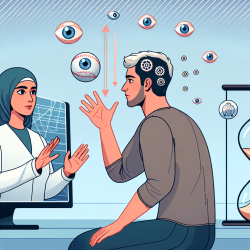Enhancing Practitioner Skills with Predictive Timing in Visuomotor Synchronization
As a speech-language pathologist dedicated to data-driven decisions, understanding the nuances of predictive timing in visuomotor synchronization can significantly enhance therapeutic outcomes for children. The research article titled Dynamic visuomotor synchronization: Quantification of predictive timing provides valuable insights that can be applied to improve our practice.
Understanding Predictive Timing
Predictive timing is the ability to synchronize what is expected with what is observed. This function is crucial for attention and is particularly relevant in the context of visual tracking. The study by Maruta et al. (2012) used a circular visual-tracking paradigm to assess predictive timing, focusing on how well individuals could synchronize their gaze with a moving target.
Key Findings
The study found that disruptions in gaze-target synchronization were often due to anticipatory saccades, which caused the gaze to temporarily lead the target. These saccades indicated that while spatial prediction was preserved, predictive timing was impaired. The researchers quantified gaze-target synchronization using several indices, revealing that instances of extremely poor performance could be identified outside the margin of error determined by test-retest measures.
Practical Applications for Practitioners
Here are some practical ways practitioners can implement the findings from this research to improve their skills and outcomes for children:
- Assessment of Attention: Use visual-tracking paradigms to assess attention in children. The study's methodology provides a robust framework for evaluating predictive timing, which is a critical component of attention.
- Identifying Impairments: Look for signs of anticipatory saccades during visual tracking tasks. These can indicate impairments in predictive timing, which may affect a child's ability to focus and process visual information effectively.
- Customized Interventions: Develop interventions that target improving predictive timing. Exercises that enhance the synchronization of internal predictions with external stimuli can be particularly beneficial.
- Use of Technology: Implement videooculography to monitor eye movements precisely and continuously. This technology can help in the accurate assessment of visual-tracking performance and the identification of specific impairments.
Encouraging Further Research
While the findings from this study are compelling, they also highlight the need for further research. Practitioners are encouraged to explore additional studies on predictive timing and visuomotor synchronization to deepen their understanding and enhance their practice.
To read the original research paper, please follow this link: Dynamic visuomotor synchronization: Quantification of predictive timing.
Conclusion
Incorporating the insights from the study on predictive timing in visuomotor synchronization can lead to better assessment and intervention strategies. By focusing on data-driven decisions and continuous learning, practitioners can create great outcomes for children, helping them achieve their full potential.










